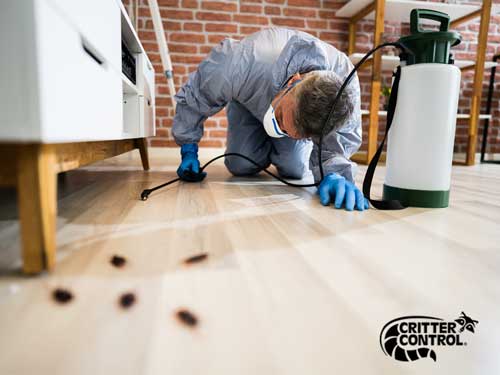Relied On A1 Exterminator Charlotte NC - Comprehensive Pest Solutions
Relied On A1 Exterminator Charlotte NC - Comprehensive Pest Solutions
Blog Article
Bed Pest Treatment Failure: Comparing Chemical Vs. Non-Chemical Solutions
In the realm of pest control, specifically when managing the consistent issue of bed insects, the option between chemical and non-chemical therapy options can be an essential one. Both strategies provide unique benefits and drawbacks, affecting elements such as performance, safety factors to consider, and total expense. By examining the nuanced information of each method, a more clear understanding of which course to pursue in attending to a bed insect problem can be attained.
Efficiency of Chemical Therapies
Chemical therapies for bed insect problems have been widely acknowledged for their quick and powerful effectiveness in removing these parasites. When taking into consideration the performance of chemical treatments, it is vital to recognize that they can provide a quick and extensive solution to a bed bug trouble. Expert exterminators frequently depend on insecticides to target bed insects at different phases of their life cycle, including nymphs, eggs, and adults. These chemicals typically work by disrupting the bed insects' nerve system, causing paralysis and ultimate death.
Additionally, chemical therapies have the advantage of offering recurring impacts, implying that they can remain to get rid of bed insects also after the first application. This residual activity is especially advantageous in combating any possible re-infestations. In addition, the fast action of chemical therapies can bring relief to people encountering serious bed bug problems, enabling them to reclaim control of their home swiftly.
Safety And Security Worry About Chemical Solutions
One essential element that needs cautious factor to consider when using chemical options for bed pest therapy is making certain the safety of occupants and the environment. Direct exposure to certain chemicals used in bed bug treatments can lead to respiratory problems, skin irritability, or various other damaging responses, particularly in people with pre-existing conditions or level of sensitivities.
In addition, the environmental impact of chemical solutions is an additional considerable consideration. Some pesticides used in bed pest therapies may be damaging to valuable insects, wildlife, and environments if they leach into the dirt or water supply. It is vital to utilize chemical therapies deliberately, complying with safety standards, and thinking about less toxic options to reduce these threats and make certain the risk-free and reliable monitoring of bed bug infestations.
Benefits of Non-Chemical Strategies
Considering the potential safety and security concerns and ecological influence connected with chemical services for bed bug therapy, exploring non-chemical methods presents a promising option with numerous distinct advantages. Non-chemical methods supply a more secure choice for houses, especially those with individuals, children, or family pets sensitive to severe chemicals. These approaches eliminate the threats of exposure to toxic materials, reducing the possibility for adverse health and wellness impacts. Furthermore, non-chemical treatments are eco-friendly, as they do not contribute to air or water contamination, making them a sustainable selection for insect control.
Additionally, non-chemical services can be effective in targeting bed insects, consisting of hard-to-reach areas where chemical therapies may not penetrate - A1 pest control services charlotte. Approaches such as warmth therapy, vacuuming, vapor cleansing, and bed mattress encasements give extensive removal without the usage of harmful chemicals.
Limitations of Non-Chemical Treatments

Additionally, non-chemical treatments frequently call for numerous applications to accomplish successful elimination. This can be time-consuming and may not constantly guarantee full removal of all bed pests and their eggs, particularly in surprise or hard-to-reach areas.
In addition, the success of non-chemical treatments heavily counts on correct execution and thoroughness, which can be challenging for people without specialist experience. Insufficient application of non-chemical techniques might result in insufficient eradication, bring about persistent invasions and the need for extra therapies.
As a result, while non-chemical therapies have their benefits, it is important to recognize these constraints and consider them when figuring out one of the most efficient strategy for taking care of bed pest problems.
Cost Comparison: Chemical Vs. Non-Chemical Options
Provided the constraints connected with non-chemical treatments, a crucial facet to examine in the context of bed insect management is the cost contrast between chemical and non-chemical choices. Chemical treatments usually include the application of insecticides by experts, which can range from $250 to $900 per room, depending on the severity of the invasion and the dimension of the location to be treated. In comparison, non-chemical therapies like heat treatment or steam can be a lot more costly, with costs varying from $1,000 to $6,000 for a whole home. While the initial price of chemical therapies might seem lower, multiple therapies might be called for to totally eliminate the invasion, potentially raising the overall cost. On the various other hand, non-chemical choices might provide a much more sustainable and environment-friendly solution, although they can be cost-prohibitive for some people. Inevitably, when taking into consideration the expense of bed bug therapy options, it is important to weigh the upfront costs versus the effectiveness and long-term sustainability of the chosen technique.
Conclusion

Taking into consideration the prospective safety and security problems and ecological impact linked with chemical solutions for bed insect therapy, exploring non-chemical methods provides a promising alternative with several distinct advantages.Offered the limitations associated with non-chemical therapies, a vital element to evaluate in the context of bed insect monitoring is the price contrast bug control near me between chemical and non-chemical alternatives. In comparison, non-chemical therapies like warmth treatment or heavy steam can be extra expensive, with expenses ranging from $1,000 to $6,000 for a whole home. While the initial price of chemical treatments go to these guys may seem reduced, multiple treatments might be required to fully remove the invasion, potentially enhancing the general cost.In conclusion, when contrasting chemical and non-chemical bed insect treatment options, it is necessary to take into consideration efficiency, safety, benefits, restrictions, and cost.
Report this page